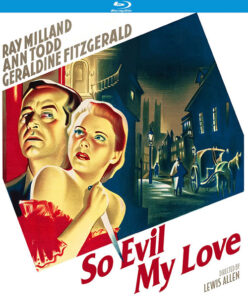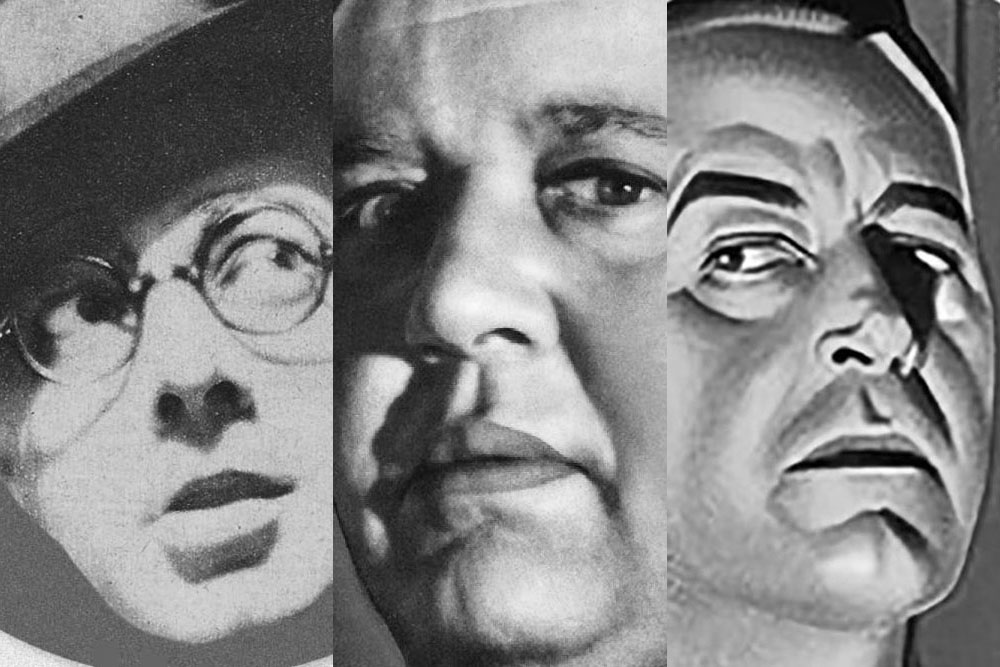


Period Film or True Noir?
Philip and Mary can’t marry because, in his morally culpable “first step” that leads to worse things (as Philip has lectured the office boy), Philip neglected to inform Mary about his wife, who refuses a divorce. Again, you may think you’re anticipating the story, but this perfectly paced 85-minute script by Bertram Milhauser, based on a novel by James Ronald and an adaptation by Arthur T. Horman, is too mature and subtle for the more vulgar motives. In a paradoxical sense, Philip perhaps is too moral.
Although murder and suspense occur with great style, The Suspect is mostly a character study of Philip. Like most Laughton films, it’s all Laughton, albeit one in which he’s supported by a rich cast and a superb crew of technicians and artists.
As revealed in many details of interaction with various people, Laughton’s anti-hero, Philip, is fundamentally sympathetic with a core of decency and goodwill that’s severely tested by some of the people around him. He’s especially tested by Cora and Gilbert and also Scotland Yard Inspector Huxley (Stanley Ridges), who would fancy himself a Columbo had that character existed yet.
At one point, Philip asserts the bromide that he believes people make their own luck. That’s a heavily ironic moment, for he dare not admit how active a part he’s taken in “his own luck”, and also because fateful circumstances are continually arranging themselves around him in a manner to provoke anyone to “make their own luck”.
Laughton’s physical actions as a not-quite-milquetoast and his every line and pause are as beautifully modulated as we tend to expect, often darting in the unexpected direction. He’s among my favorite actors and I believe he never gave a bad performance if that means a dull one. He’s sometimes accused of being hammy–especially when it works for the role–but that camera and the audience’s eyes remain fastened on him for good reason.
Mavens of visual style must lick their lips at Paul Ivano’s rich, high-contrast black and white photography and mobility. This sumptuous photography comes to the fore during a tour-de-force in which Huxley imagines a murder via subjective camera. One teasing suspense scene orchestrates many impeccable details, including a subtle moment when someone turns up the gas chandelier offscreen and Philip looks toward the offscreen space becoming lighter. At scene’s end, the relieved Philip turns it down again.
Siodmak’s direction of every elements reveals intelligence, taste, and total engagement. We gather he feels at home exploring the traps of narrow semi-detached houses and equally narrow, mortally attached spouses, not to mention the whole neighborhood of polite clueless hypocrites whose gossip is just as likely off the mark as on.
The openly vicious and unpleasant characters, Cora and Gilbert, are played with gusto, and they contrast beautifully. In fact, they’re never in the same scene. We can’t completely call this a noir vision, however, as too many characters feel like genuinely good people. This is arguably a more complex vision than the typical noir in which everyone’s compromised or miserable in a hopeless, hostile universe.
Transferred from a 2K master, this Blu-ray does justice to every physical and emotional detail of The Suspect‘s world. Critic Troy Howarth‘s amiable commentary stresses the historical background of cast and crew and points out why some prominent noir critics have classed this as more of a period film than a true noir, a position that acknowledges overlap. The Suspect certainly comes in the middle of Siodmak’s noir cycle at Universal and falls somewhere on the spectrum.
So Evil My Love (1948) Director: Lewis Allen
As with The Suspect, So Evil My Love is a period film in a wretchedly class-conscious London. 1940s critics called this Victorian-Edwardian subgenre “gaslight thrillers” or “gaslight melodramas” in reference to Patrick Hamilton‘s play Gas Light (1938) and its film versions.
So Evil My Love‘s source is one of the novels published by Marjorie Bowen under her pseudonym Joseph Shearing, which she used for novels inspired by real crimes as modified into fiction. The highly engaging commentary by Imogen Sara Smith, alive to social meanings in this film and its brethren, discusses the real case that Bowen fashioned to her purposes.
The film opens at sea, where the heroine feels free in the wind and rain. The first of many ironies is that she’ll spend the rest of the film on land while feeling “at sea” in a way she never did on the ocean.
Olivia Harwood (Ann Todd) is approached by the captain (Finlay Currie) to help nurse feverish patients, based on her experience doing the same as a missionary’s wife in Jamaica. “You can help your own folk now,” he says in his Scots burr.
She’s reluctant because, as a widow, she’s glad to leave all that behind. We’ll gather that nothing about that life or marriage satisfied her emotionally or physically. She also takes umbrage that the captain, whom she calls an atheist, tries to exploit her Christian conscience, and then she capitulates to it. This scene encapsulates her character’s paradoxes as explored in the rest of the film.
The next scene introduces a delirious patient, Mark (Ray Milland), whose ravings imply that he’s a fugitive, which he is. When he’s better, he wants to make sure he confessed nothing culpable and she reassures him. He’ll inveigle his way into her genteel widowhood by applying as a lodger in her home, and this leads to their strange, torrid, tempestuous romance into which she goes with eyes wide open. She declares that she’s never truly known a man, as the dialogue strongly implies she crosses the line of sexual propriety with this sly, brash modern painter who’s also a thief and a bounder.
As Smith says, nailing it, “what makes this story complicated and satisfying is that he both empowers her and corrupts her, frees her and destroys her. She blossoms into her true self and becomes a monster.”
Mark is a homme fatale (fatal man), a type more common in British noirs, but he’s one who never really fools his mark. Unlike most of his type, he’s perceived more or less clearly by his supposed sucker. She meets him halfway, and that’s why he’s so disturbed that he may admit to feelings he doesn’t trust. “You aren’t afraid of me. You’re afraid of yourself,” he avows. Mark catalyzes her properly repressed hunger: physical, social, financial. Olivia goes back and forth in her conscience, and witnessing this tension and balance is part of the film’s fascination.
The main part of the story involves her best friend from school, who’s drawn a different number in the marriage lottery. Susan Courtney (Geraldine Fitzgerald) has married very well, if judged by the mansion, and disastrously if judged by the cold, tyrannical, socially ambitious barrister of a husband who’s driving her to alcoholism while terrorizing her about his inability to father a child.
Although top-billed Milland is off screen much of the time, we don’t miss him because this is Todd’s film and she carries it with brilliant support from Fitzgerald and the whole array of top-drawer character players: Raymond Huntley as Susan’s husband, Martita Hunt as his gorgon mother, Leo G. Carroll as a manipulative detective of almost supernatural presence, Raymond Lovell as a shady art dealer, Hugh Griffith as the coroner, and a good dozen others.
This is very much a “woman’s film”; that is, a melodrama centered on the choices women make from the limited choices they have, and in this case the relationship between two women. Poison is a central device and metaphor, for everyone is either poisonous or poisoned or both. The story’s many themes include the luck of marriage, the social subordination of women, how a male justice system is both ignorant and inexorable, how class resentment and money are their own kind of poison and motivational medicine, how sex is powerful, how art is commercial, and even the meaning of love.
Is it film noir or just an alleged true-crime thriller, or a period piece, or a woman’s romantic melodrama? Noir isn’t so much a genre as a tone, and here the tone enters via the moral ambiguity of the characters, who continually arouse our sympathy and revulsion at once, and the bleak vision of society at its most excruciatingly proper and hypocritical. While working in some of the same territories as The Suspect, So Evil My Love is easily the darker film.
Paramount produced the picture in England with a British cast and crew. A technical highlight is Max Greene’s photography, gorgeously showcased in this 2K transfer. Another early 1930s emigrant from the growing Nazi threat, Greene was among those who went to England instead of Hollywood. One of his rewards was shooting Jules Dassin‘s Night and the City (1950), the ultimate bleak London noir.
English director Lewis Allen was under contract at Paramount, where his debut was the creepy ghost story The Uninvited (1944) starring Milland. As Smith points out, Milland’s persona evolved at Paramount from light heroes to darker roles, like Lang’s Ministry of Fear (1944) and his Oscar-winning turn in Billy Wilder‘s The Lost Weekend (1945). Mark initially appears a shallow type, but Milland convincingly suggests his depths and contradictions, as revealed in the script by Leonard Spigelgass and Ronald Millar.
While absorbing this meticulously constructed, deeply and ambiguously characterized, deliberately paced, brilliantly acted melodrama of corruption and perversion in a stuffy, uptight Victorian milieu, I thought there was a period in my life when I might have been impatient with such a thing. I’m better now. We can’t have enough films this stylish and intelligent, or with women characters this acutely portrayed.


![Call for Papers: All Things Reconsidered [MUSIC] May-August 2024](https://www.popmatters.com/wp-content/uploads/2024/04/all-things-reconsidered-call-music-may-2024-720x380.jpg)



